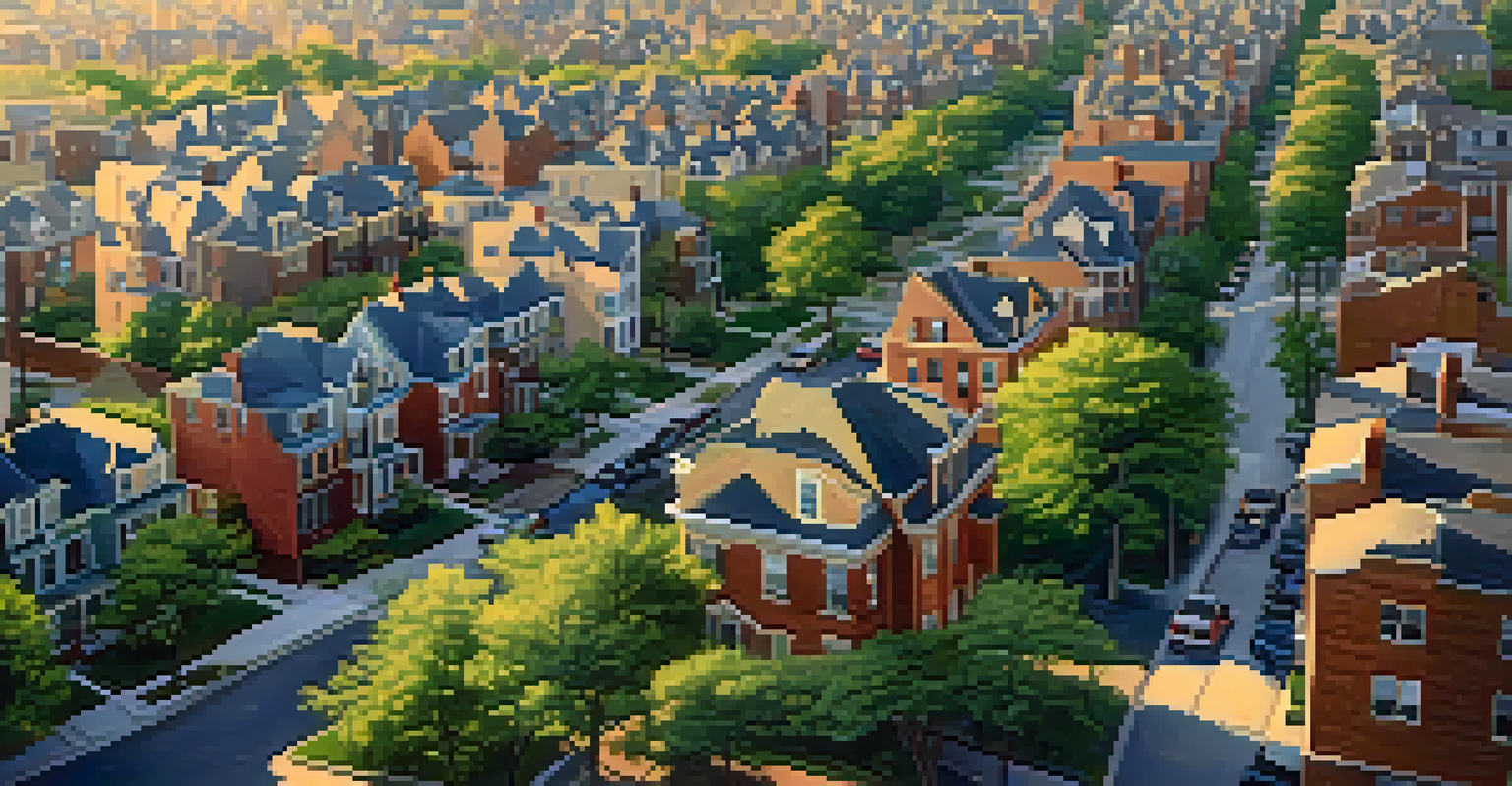The Role of Zoning Laws in NYC's Housing Affordability Crisis

What Are Zoning Laws and Their Purpose?
Zoning laws are regulations that dictate how land can be used in a community. They help shape the development of neighborhoods by specifying whether areas can be residential, commercial, or industrial. In essence, zoning ensures that land use is organized and that developments are compatible with one another, promoting orderly growth and protecting property values.
Zoning laws are not only about land use; they shape our communities and influence the very fabric of our cities.
For instance, a zone designated for residential use might restrict the construction of factories or large commercial buildings that could disrupt the peaceful nature of a neighborhood. This organization is crucial in a bustling city like New York, where the balance between different types of developments is delicate. However, these laws can also have unintended consequences, particularly in relation to housing affordability.
By regulating what can be built and where, zoning laws can create barriers to new housing developments. This often leads to a limited supply of affordable housing, as developers may be unable to meet the growing demand for various housing types, particularly in densely populated areas.
The Impact of Zoning on Housing Supply
One of the most significant effects of zoning laws on NYC's housing market is the restriction they place on supply. When zoning regulations limit the types of buildings that can be constructed, it can inadvertently constrain the housing market. For example, if an area is zoned only for single-family homes, developers cannot build multi-family units, which are often more affordable.

As demand for housing continues to rise in New York City, this limited supply can drive up prices, creating a competitive market that many residents can't afford. For every new luxury condo that goes up, there may be fewer options for lower-income families. This imbalance highlights the urgent need to reassess zoning regulations to better align with the current housing crisis.
Zoning Laws Shape Neighborhoods
Zoning laws regulate land use, ensuring orderly development and compatibility among different types of properties.
Moreover, the complexities of zoning laws can deter developers from even attempting to build affordable housing. The lengthy approval processes and the bureaucratic nature of navigating these laws can often lead to developers prioritizing more profitable projects over those that serve the community’s needs.
Zoning Laws and Gentrification
Gentrification is a term that often accompanies discussions about urban development, and zoning laws play a significant role in this phenomenon. As neighborhoods become more desirable, zoning can influence which areas receive investment and development. Unfortunately, this can lead to the displacement of long-term residents who can no longer afford rising rents.
The challenge of affordable housing is not just about supply, but about ensuring that every community remains inclusive and accessible.
For example, in neighborhoods where zoning laws have been relaxed to allow for more upscale developments, long-time residents may find themselves pushed out as property values and rents climb. This scenario creates a cycle where affordable housing becomes increasingly scarce, exacerbating the affordability crisis.
To combat this, some advocates suggest implementing inclusionary zoning, which requires developers to include a percentage of affordable units in new developments. This approach aims to ensure that as neighborhoods evolve, they remain accessible to a diverse range of residents rather than catering exclusively to wealthier newcomers.
The Role of Community Boards in Zoning Decisions
In New York City, community boards play a crucial role in the zoning process, acting as the bridge between residents and city planners. These boards review proposed developments and provide recommendations, often reflecting the community's interests and concerns. However, their influence can lead to conflicting priorities, especially when it comes to housing affordability.
While community boards aim to protect local interests, their resistance to certain developments can hinder the creation of much-needed affordable housing. For example, a community board might oppose a new apartment building due to fears it could alter the neighborhood’s character, even if it offers lower-income housing options.
Zoning Impacts Housing Affordability
Restrictive zoning regulations can limit housing supply, driving up prices and creating challenges for affordable housing.
This dynamic highlights the importance of finding a balance between preserving community identity and meeting the urgent need for affordable housing. Engaging residents in constructive dialogue about zoning changes can help align community goals with the broader need for housing accessibility.
Potential Solutions to Zoning Challenges
Addressing the housing affordability crisis in NYC requires innovative solutions to zoning challenges. One approach is to amend existing zoning laws to allow for more diverse types of housing, such as mixed-use developments that combine residential and commercial spaces. This can create vibrant communities while increasing the supply of affordable units.
Another potential solution is to streamline the zoning approval process, making it easier and faster for developers to build affordable housing. By reducing bureaucratic red tape, the city can encourage more developers to invest in affordable housing projects that align with community needs.
Additionally, implementing policies that incentivize the construction of affordable units—like tax breaks or grants—can motivate developers to prioritize these projects. These solutions can help create a more balanced and inclusive housing market, ultimately benefiting all New Yorkers.
Case Studies of Zoning Reforms in Other Cities
Looking at how other cities have approached zoning reforms can provide valuable insights for New York. For example, cities like Minneapolis have successfully eliminated single-family zoning, allowing for more diverse housing options to be built. This bold move has led to an increase in affordable housing units while also fostering a more inclusive community.
Similarly, cities such as Portland have implemented policies to encourage the development of accessory dwelling units (ADUs), which offer additional affordable housing options within existing neighborhoods. These reforms not only address housing supply but also allow residents to remain in their communities as they age or face financial challenges.
Community Boards Influence Zoning
Community boards play a vital role in zoning decisions, balancing local interests with the need for affordable housing development.
By examining these case studies, NYC can learn from the successes and challenges of other urban centers. Implementing similar reforms tailored to the unique context of New York could lead to significant improvements in housing affordability and community cohesion.
The Future of Zoning and Housing Affordability in NYC
As NYC grapples with its housing affordability crisis, the future of zoning laws will undoubtedly be a hot topic. The city's leaders must recognize that outdated zoning regulations can no longer serve the needs of a growing and diverse population. A forward-thinking approach to zoning that prioritizes affordable housing can pave the way for a more equitable urban landscape.
Engaging stakeholders—from community members to developers—will be essential in crafting zoning reforms that address the crisis effectively. By fostering collaboration, NYC can create solutions that not only promote development but also maintain the character and inclusivity of its neighborhoods.

Ultimately, the goal should be to create a city where everyone has access to safe and affordable housing. Rethinking zoning laws is a critical step in achieving this vision, ensuring that New York City remains a place where diverse communities can thrive together.